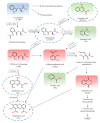Immune Influencers in Action: Metabolites and Enzymes of the Tryptophan-Kynurenine Metabolic Pathway
- PMID: 34202246
- PMCID: PMC8301407
- DOI: 10.3390/biomedicines9070734
Immune Influencers in Action: Metabolites and Enzymes of the Tryptophan-Kynurenine Metabolic Pathway
Abstract
The tryptophan (TRP)-kynurenine (KYN) metabolic pathway is a main player of TRP metabolism through which more than 95% of TRP is catabolized. The pathway is activated by acute and chronic immune responses leading to a wide range of illnesses including cancer, immune diseases, neurodegenerative diseases and psychiatric disorders. The presence of positive feedback loops facilitates amplifying the immune responses vice versa. The TRP-KYN pathway synthesizes multifarious metabolites including oxidants, antioxidants, neurotoxins, neuroprotectants and immunomodulators. The immunomodulators are known to facilitate the immune system towards a tolerogenic state, resulting in chronic low-grade inflammation (LGI) that is commonly present in obesity, poor nutrition, exposer to chemicals or allergens, prodromal stage of various illnesses and chronic diseases. KYN, kynurenic acid, xanthurenic acid and cinnabarinic acid are aryl hydrocarbon receptor ligands that serve as immunomodulators. Furthermore, TRP-KYN pathway enzymes are known to be activated by the stress hormone cortisol and inflammatory cytokines, and genotypic variants were observed to contribute to inflammation and thus various diseases. The tryptophan 2,3-dioxygenase, the indoleamine 2,3-dioxygenases and the kynurenine-3-monooxygenase are main enzymes in the pathway. This review article discusses the TRP-KYN pathway with special emphasis on its interaction with the immune system and the tolerogenic shift towards chronic LGI and overviews the major symptoms, pro- and anti-inflammatory cytokines and toxic and protective KYNs to explore the linkage between chronic LGI, KYNs, and major psychiatric disorders, including depressive disorder, bipolar disorder, substance use disorder, post-traumatic stress disorder, schizophrenia and autism spectrum disorder.
Keywords: autism spectrum disorder; bipolar disorder; chronic inflammation; depression; immune tolerance; inflammatory factor; kynurenic acid; kynurenine; low-grade inflammation; post-traumatic stress disorder; schizophrenia; substance use disorder.
Conflict of interest statement
The authors declare no conflict of interest.
Figures



Similar articles
-
The impact of electroconvulsive therapy on the tryptophan-kynurenine metabolic pathway.Brain Behav Immun. 2015 Aug;48:48-52. doi: 10.1016/j.bbi.2015.02.029. Epub 2015 Mar 9. Brain Behav Immun. 2015. PMID: 25765557
-
Selective association of cytokine levels and kynurenine/tryptophan ratio with alterations in white matter microstructure in bipolar but not in unipolar depression.Eur Neuropsychopharmacol. 2022 Feb;55:96-109. doi: 10.1016/j.euroneuro.2021.11.003. Epub 2021 Nov 27. Eur Neuropsychopharmacol. 2022. PMID: 34847455
-
Does tryptophan degradation along the kynurenine pathway mediate the association between pro-inflammatory immune activity and depressive symptoms?Psychoneuroendocrinology. 2014 Jul;45:202-10. doi: 10.1016/j.psyneuen.2014.03.013. Epub 2014 Apr 5. Psychoneuroendocrinology. 2014. PMID: 24845191
-
Effect of immune activation on the kynurenine pathway and depression symptoms - A systematic review and meta-analysis.Neurosci Biobehav Rev. 2020 Nov;118:514-523. doi: 10.1016/j.neubiorev.2020.08.010. Epub 2020 Aug 24. Neurosci Biobehav Rev. 2020. PMID: 32853625 Free PMC article.
-
The tryptophan catabolite or kynurenine pathway in schizophrenia: meta-analysis reveals dissociations between central, serum, and plasma compartments.Mol Psychiatry. 2022 Sep;27(9):3679-3691. doi: 10.1038/s41380-022-01552-4. Epub 2022 Apr 14. Mol Psychiatry. 2022. PMID: 35422466
Cited by
-
Gender-associated role in patients with schizophrenia. Is there a connection with the resistance?Front Psychiatry. 2022 Aug 10;13:995455. doi: 10.3389/fpsyt.2022.995455. eCollection 2022. Front Psychiatry. 2022. PMID: 36032251 Free PMC article.
-
Vascular Endothelial Growth Factor as a Potential Biomarker of Neuroinflammation and Frontal Cognitive Impairment in Patients with Alcohol Use Disorder.Biomedicines. 2022 Apr 20;10(5):947. doi: 10.3390/biomedicines10050947. Biomedicines. 2022. PMID: 35625687 Free PMC article.
-
First Metabolomic Signature of Blood-Brain Barrier Opening Induced by Microbubble-Assisted Ultrasound.Front Mol Neurosci. 2022 Jun 20;15:888318. doi: 10.3389/fnmol.2022.888318. eCollection 2022. Front Mol Neurosci. 2022. PMID: 35795688 Free PMC article.
-
Natural and Induced Tolerance to Hymenoptera Venom: A Single Mechanism?Toxins (Basel). 2022 Jun 22;14(7):426. doi: 10.3390/toxins14070426. Toxins (Basel). 2022. PMID: 35878164 Free PMC article.
-
Neuropharmacological Modulation of N-methyl-D-aspartate, Noradrenaline and Endocannabinoid Receptors in Fear Extinction Learning: Synaptic Transmission and Plasticity.Int J Mol Sci. 2023 Mar 21;24(6):5926. doi: 10.3390/ijms24065926. Int J Mol Sci. 2023. PMID: 36983000 Free PMC article. Review.
References
-
- Margină D., Ungurianu A., Purdel C., Tsoukalas D., Sarandi E., Thanasoula M., Tekos F., Mesnage R., Kouretas D., Tsatsakis A. Chronic Inflammation in the Context of Everyday Life: Dietary Changes as Mitigating Factors. Int. J. Environ. Res. Public Health. 2020;17:4135. doi: 10.3390/ijerph17114135. - DOI - PMC - PubMed
-
- Dinh K.M., Kaspersen K.A., Mikkelsen S., Pedersen O.B., Petersen M.S., Thørner L.W., Hjalgrim H., Rostgaard K., Ullum H., Erikstrup C. Low-grade inflammation is negatively associated with physi;cal Health-Related Quality of Life in healthy individuals: Results from The Danish Blood Donor Study (DBDS) PLoS ONE. 2019;14:e0214468. doi: 10.1371/journal.pone.0214468. - DOI - PMC - PubMed
Publication types
Grants and funding
LinkOut - more resources
Full Text Sources

